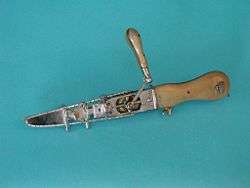Bernhard Heine
| Bernhard Heine | |
|---|---|
|
The German physician Bernhard Heine | |
| Born |
August 20, 1800 Schramberg, Germany |
| Died |
July 31, 1846 (aged 45) Thun, Switzerland |
Bernhard Heine (August 20, 1800, Schramberg (Black Forest) – July 31, 1846, Glockenthal near Thun (Switzerland)) was a German physician, bone specialist and the inventor of the osteotome, a medical tool for cutting bones.
Biography
Apprenticeship in Würzburg
Bernhard Heine was born on August 20, 1800 as the son of a tanner in Schramberg. At the age of ten (according to other references, thirteen) years he was apprenticed to his uncle Johann Georg Heine in Würzburg as an orthopaedic mechanic. Without any enrolment he later attended lectures in medicine at the University of Würzburg. After a number of journeys he took over his own department in his uncle's orthopaedic institute. When Johann Georg moved to the Netherlands in 1829 Bernhard - together with his cousin Joseph Heine - became the head of the Würzburg institution. In 1837 Bernhard Heine married his cousin (Johann Georg's daughter) Anna Heine (*1801).
Inventing the osteotome
In 1830, after long years of research and development, Bernhard Heine presented a medical tool to his colleagues. It was a "bone saw", which he called osteotome and which revolutionized surgical treatment. His invention was a great success among medical experts all over Europe. Heine travelled to other parts of Germany, France and even Russia to present it to other surgeons. In 1836 already a doctoral thesis on the "Osteotome and its application" was published in Munich.


| left: the osteotome | right: its various parts and its usage |
|---|
Heine declined an offer of the Russian Tsar Nicholas I to take over the position of an orthopaedic senior consultant at the imperial school in Kronstadt and returned to Würzburg. The Würzburg university awarded him an honorary doctorate in 1836 and an honorary professorship in 1838, although he had never acquired any degree.
Research work on bone formation
Bernhard Heine acquired valuable knowledge in the field of bone formation and bone regeneration, which is still valid today. He was able to prove that the periosteum, the tissue covering the bones, is decisive in bone regeneration and therefore has to be spared violation in the operating process. Unfortunately his early death did not allow him to publish his findings in a medical work. Since 1844 he had taught Experimental Physiology at the Würzburg university as an associate professor, but fell ill with tuberculosis and died on July 31, 1846 on a recreation trip to Switzerland in Glockenthal near Thun. It was not until 1926, eighty years after his death that his research findings were published (see external link biography).
Bibliography
- Heinz Hansen: Die Orthopädenfamilie Heine - Leben und Wirken der einzelnen Familienmitglieder im Zeichen einer bedeutenden deutschen Familientradition des neunzehnten Jahrhunderts. doctoral thesis, Dresden 1993
- Hans Hekler: Bernhard Heine – von Königen geehrt und von Zar Nikolaus umworben. in: D'Kräz (Beiträge zur Geschichte der Stadt und Raumschaft Schramberg) Heft 10, Schramberg 1990 (also online, see external links)
External links
- biography with pictures and further references
|
